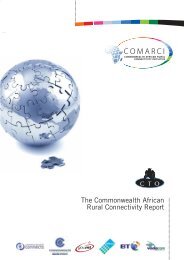Guide to measuring information and ... - unesdoc - Unesco
Guide to measuring information and ... - unesdoc - Unesco
Guide to measuring information and ... - unesdoc - Unesco
Create successful ePaper yourself
Turn your PDF publications into a flip-book with our unique Google optimized e-Paper software.
ED27 Average number of computers connected <strong>to</strong> the Internet per educational institution (for ISCED<br />
levels 1-3, level 4 <strong>and</strong> levels 5-6)<br />
Definition:<br />
The number of computers connected <strong>to</strong> the Internet in<br />
educational institutions divided by the <strong>to</strong>tal number of<br />
educational institutions (for ISCED levels 1-3, level 4<br />
<strong>and</strong> levels 5-6).<br />
Data requirement:<br />
(CI) Number of available computers connected <strong>to</strong> the<br />
Internet for ISCED levels 1-3, level 4 <strong>and</strong> levels 5-6.<br />
(refer <strong>to</strong> questionnaire item C.2.4)<br />
(EI) Number of educational institutions (public <strong>and</strong><br />
private) for ISCED levels 1-3, level 4 <strong>and</strong> levels 5-6.<br />
(refer <strong>to</strong> questionnaire item C.1)<br />
Formula:<br />
3<br />
CI<br />
h 1<br />
3<br />
EI<br />
h 1<br />
Where:<br />
t<br />
h t<br />
CI h 4<br />
t , t ,<br />
h EI h 4<br />
6<br />
CI<br />
h 5<br />
6<br />
EI<br />
h 5<br />
t<br />
h<br />
t<br />
h<br />
- 59 -<br />
Purpose:<br />
To measure the overall availability of Internetconnected<br />
computers in educational institutions.<br />
Method of collection:<br />
Administrative data collection through annual census<br />
or survey of educational institutions (or extract data<br />
from the records of educational institutions).<br />
Data source(s):<br />
Statistical unit of the relevant ministries/ departments<br />
of education or, alternatively, the national statistical<br />
office.<br />
CI t<br />
= Number of available computers connected <strong>to</strong> the Internet at education level h in school-year t<br />
h<br />
EI t<br />
h = Number of educational institutions at level of education h in school-year t<br />
Analysis <strong>and</strong> interpretation:<br />
A higher value for this indica<strong>to</strong>r implies greater<br />
availability of computers connected <strong>to</strong> the Internet on<br />
average in educational institutions, hence a higher level<br />
of e-readiness. A greater variance between countries<br />
may signal a certain degree of “digital divide” among<br />
countries.<br />
When calculated <strong>and</strong> analysed by ISCED levels,<br />
geographical regions, urban/rural areas <strong>and</strong> for<br />
individual educational institutions, this indica<strong>to</strong>r can<br />
reflect the “digital divide” in terms of the availability of<br />
computers connected <strong>to</strong> the Internet in schools within<br />
countries.<br />
More precise indications of e-readiness can be obtained<br />
by calculating this indica<strong>to</strong>r based on the number of<br />
computers connected <strong>to</strong> the Internet used for<br />
pedagogical purposes.<br />
Methodological <strong>and</strong> definition issues or<br />
operational limitations:<br />
See Appendix II for a more detailed definition of<br />
computer (where applicable, student-owned lap<strong>to</strong>ps or<br />
PDAs with wired or wireless Internet connectivity used<br />
as part of recommended pedagogical kits must be<br />
counted).<br />
The typical measure for a Gini Coefficient might reveal<br />
a spatial inequality in the distribution of computers<br />
connected <strong>to</strong> the Internet across the entire country in<br />
favour of some elite or private educational institutions<br />
where a greater number (or even 100%) of computers<br />
are available <strong>to</strong> learners.
















